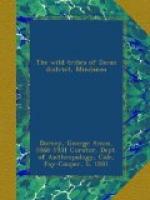At some unrecorded date a considerable, portion of the tribe migrated to the east side of Davao Gulf, and settled near Cape San Agustin, where, it is said, they now number more than two thousand.
The name Tagakaolo signifies “those who dwell at the head of the river,” and is applied to all the hill people living between the coast and the country of the Bila-an. They have always been broken up into small groups, often at war with one another, yet they appear to be quite uniform in type, language, and religious beliefs. In recent years many of them have been induced to come down to the coast plantations, but the great majority still remain in the mountains. They are of a turbulent, warlike disposition, and have been a constant source of trouble to the Spanish and American authorities.[1] At the time of the writer’s visit they had joined with the Kulaman in raiding the coast settlements, and, as a result, were being vigorously pursued by the American troops; for this reason it was only possible to gain information from those remaining on the plantations.
[1] Members of this tribe were responsible for the murder of Governor Bolton.
The total number of persons making up the tribe is estimated at six thousand, but this is at best a mere guess.
There is scarcely any variation in physical type between the Kagan branch and the Tagakaolo proper, while for the whole tribe there is less variation between its members than in any group so far discussed.
The following results were obtained by measurements on twenty-seven men:
Maximum height 166.6 cm.; minimum 151.3 cm.; average 157.4 cm.
Cephalic indices—Maximum 89.7; minimum 76.3; average 81.5.
Length-height indices—Maximum 79.0; minimum 63.1, average 70.0.
These tables show that aside from being more short-headed, this tribe differs little from the Bagobo, Bila-an, and Kulaman. Like the Kulaman, they have high foreheads, often full and vaulted but quite as frequently retreating from well-marked supra-orbital ridges. They are slightly more prognathous than the Kulaman, and in the majority of cases the hair is curled in locks. The teeth are usually mutilated and blackened, while shaving of the eyebrows and tattooing of the left forearm and breast are quite common.
The historians of the tribe tell us that all the Tagakaolo are descended from Lakbang, MEngEdan, and his wife Bodek. In the beginning these three persons lived on a small island in the sea. Two children, Linkanan and Lampagan, were born to them and they in turn were parents of two birds—the kalau and sabitan. These birds flew away to other places and returned with bits of soil which their parents patted and moulded with their hands until they had formed the earth. Other children were born and from them have come all the people who now inhabit the land.
Two powerful spirits, Diwata and TimanEm, watched the formation of the world, and when it was completed the latter spirit planted trees upon it. He still takes considerable interest in the affairs of men and each year sends the spirits Layag and Bangay,[1] as stars, to tell the people when to prepare their land for the planting of crops.




